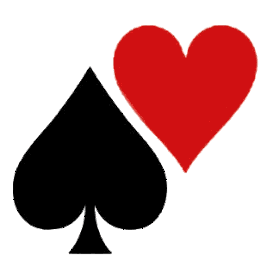Spar eller Hjerter
 Sparts is a combination of Spades and Hearts, where the player who is dealt the 7 of diamonds chooses which game to play that hand.
Sparts is a combination of Spades and Hearts, where the player who is dealt the 7 of diamonds chooses which game to play that hand.
Antall spillere: 4
Lengde: 22 mn
Kompleksitet: 3 / 5
Spill Spar eller Hjerter og 1194 andre spill online.
Ingen nedlasting nødvendig - spill direkte fra nettleseren din.
Med vennene dine og tusenvis av spillere fra hele verden.
Gratis.

Spill Spar eller Hjerter og 1194 andre spill online.
Ingen nedlasting nødvendig - spill direkte fra nettleseren din.
Med vennene dine og tusenvis av spillere fra hele verden.
Gratis.

Regelsammendrag
Overview
Standard 52-card pack, ranked A (high) to 2 (low).
Sparts is a combination of the well-known card games Spades and Hearts. Both games involve following suit, taking tricks, and scoring points. When the game ends (at a predetermined number of points), the player with the most points wins!
The Deal
Each player is dealt a hand of cards. You will see your hand at the bottom of the play area on your browser screen. In a standard four-person game, you will have 13 cards in hand.
The player holding the 7♦ chooses whether to play Spades or Hearts for that hand only. They can make this decision based on the cards they're holding (see strategy tips about what makes a strong hand in each game). If you are the player making the choice, you'll see two buttons at the top of the play area asking you which game you'd like to play. Click on one to start that game.
Spades
After someone has chosen Spades, all players will have an opportunity to bid for the number of tricks they believe they can take. A trick is when all players have played their cards for that turn (see below); the player with the highest card takes the trick. The bid must be at least 2 and may be as high as the number of cards in your hand (13 for a four-person game). It's also possible to bid nil (zero), which means you think you won't take any tricks, and in fact will actively work to avoid them. You cannot bid 1. Bids are made in turn order, starting with the first player and proceeding clockwise (left) around the table.
Each player's bid is noted in the game log on the side of the page, and shown on their player area. For example, if you bid 3 you will have text that says "0 / 3" beneath your name. This indicates you've taken 0 tricks of the 3 you bid.
Playing the hand
After everyone has bid, the first player plays a card to start the trick. Each player, in order, then plays a card on the trick. You must follow suit if you can; that means if (for example) a diamond was played, you must play a diamond if you have one in your hand. If not, you can play a card of any other suit, including a ♠. After each player has played their card, the highest card wins the trick. The highest card is the one in the suit that was led (such as ♦), unless there are one or more ♠ played on the trick. ♠ are the trump suit and beat all other suits. If there are ♠ on the trick, the highest ♠ is the winner. Cards of other suits (such as ♣ or ♥, in this example) do not count for anything.
When a player wins a trick, the trick counter beneath their name is automatically updated to show how many tricks they've taken in all, and how many they originally bid. If you bid 3 as above, your player area will show "1 / 3" after taking your first trick. This helps you know your progress and that of the other players.
When the first ♠ is played on a trick, it is called breaking spades (or breaking trump). From this point on, a ♠ may be the first card played on a trick. However, if spades have not been broken, they cannot be led. The only exception is if a player has only spades remaining in their hand, because obviously they have no choice but to play one.
The player who takes the trick then starts the next trick by playing a card. Play continues in this way until all the tricks have been played.
Scoring
All players count the tricks they've taken during the hand, and compare that with the number they bid. If you made or exceeded your bid, you receive 10 times your bid. Any tricks above the bid count as 1 point each. For example, if you bid 3 and took 4 tricks, you'll receive 31 points: 10 × 3 bid, plus 1 overtrick or bag. A bid of nil (zero) is worth 50 points.
The number of bags is tracked, and shown in the score area on the top right of the page. After you've taken too many bags (by taking more than you bid), you will be penalised. The number of bags, and the penalty, are based on the length of the game, as follows:
- 200-point game = 4 bags or more, penalty 40 points
- 400-point game = 8 bags or more, penalty 80 points
- 800-point game = 8 bags or more, penalty 80 points
Thus, it's important to bid as accurately as possible, and once you've made your bid you will often want to "slough" cards so you don't take any more tricks.
If you do not make your bid, you lose 10 times your bid. For instance, if you've bid 3 and only took 2, you'll be penalised 30 points: 10 × 3 bid. Losing a nil bid by taking one or more tricks will penalise you 50 points. If you lose a nil bid, the extra tricks you've taken are not counted as bags.
Hearts
If Hearts is chosen as the game, all players will have an opportunity to pass cards from their hand to another player. The number of cards to pass is chosen as a game option: it can be either 4 (Sparts mode) or 3 (Traditional Hearts mode). The first time Hearts is played, cards are passed to the player on your left. The second time, the cards are passed right. The third time, they are passed across the table. And the fourth time, no cards are passed. Then the cycle repeats.
Playing the hand
After everyone has passed their cards, the first player plays a card to start the trick. In Traditional Hearts mode, the first play must be the 2♣ and the first trick can't have a point card played on it. Like Spades, each player goes in turn around the table and must follow suit if possible. There is no trump suit, so the highest card in the suit that was led is the one that takes the trick.
Similar to Spades, when a ♥ is played on a trick, it is called breaking hearts. From this point on, a ♥ may be the first card played on a trick. If hearts have not been broken, they cannot be led. Of course, if you have only ♥ in your hand, you can lead one. If you're playing in Sparts mode, playing the Q♠ also counts as breaking hearts because that card is a penalty card (see Scoring below).
The player who takes the trick starts the next trick, and play continues until all tricks have been finished.
Scoring
All players are awarded 40 points. Then, each heart they took during the hand subtracts 2 from that score. For example, if you took a total of ten ♥s during the hand, you'll be penalised 20 points (10 × 2) for a score of 20.
The player who takes the Q♠ is penalised 26 points. This means the Q♠ is worth the same penalty as all of the 13 ♥. If you took 10 ♥, as above, and the Q♠, your score will be -6: 40 minus 20 for the ♥, minus the additional 26 for Q♠.
If you take no tricks at all during the hand, you receive 50 points instead of the usual 40.
However, if any player takes all 13 ♥ and the Q♠ (all the penalty cards), that player receives 50 points and all other players receive none. This is called "shooting the moon".
End of game
After each hand, all players' scores are updated in the score area. When at least one player's score reaches the total points for the game, the game ends. The player with the highest score is the winner.

